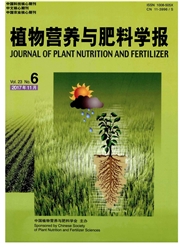

 中文摘要:
中文摘要:
【目的】退耕还林还草是防治我国西部土壤侵蚀、恢复土壤肥力的最重要措施。本研究选择陕北黄土高原的神木、吴旗典型丘陵退耕还林还草区,研究不同退耕年限草(苜蓿)灌(沙棘)植被提高0—10 cm表层土壤有机碳、速效氮和全氮储量和各级土壤水稳性团聚体含量分布的有效性,旨在揭示退耕还林工程提高坡耕地土壤质量的有效性机理,为我国坡耕地土壤肥力提高措施的选择提供科学依据。【方法】应用空间替代时间的方法,选择土壤类型和坡度一致的三个不同退耕年限的全坡地景观(包括坡上部、坡中部和坡下部),采集土壤样品,分析有机碳等指标。【结果】草灌植被提高土壤有机碳、速效氮和全氮储量及土壤水稳性团聚体含量的效应随退耕年限的增加而增加;种植5年的沙棘林坡地土壤有机碳、全氮和速效氮储量相对于退耕前分别提高了1.4、0.5、0.3倍,种植10年以上沙棘林地分别提高了6.6、2.4、1.5倍;种植5年苜蓿使坡耕地土壤有机碳、全氮和速效氮储量分别提高了0.4、0.1、5.0倍,种植10年以上苜蓿地分别提高了0.7、0.3、5.2倍。种植5年和10年以上的沙棘林提高坡耕地土壤总有机碳的效应分别是种植5年和10年以上苜蓿的3.4和9.5倍;种植5年和10年以上的沙棘林提高坡地土壤全氮储量的效应分别比种植5年和10年以上苜蓿大9倍以上。坡耕地种植5年苜蓿提高土壤速效氮的效应是种植5年沙棘林的19.2倍,种植10年以上的苜蓿提高土壤速效氮的效应是种植10年以上沙棘林的3.4倍。沙棘林对土壤有机碳和全氮的提高效应显著大于苜蓿,而苜蓿对土壤速效氮含量的增加效应显著大于沙棘林。沙棘和苜蓿在提高坡地土壤有机碳和全氮储量的差异大小与退耕前坡地土壤有机碳和全氮储量水平有关,而土壤速效氮储量的差异与其根系的固氮功能差异密切相关,苜蓿根
 英文摘要:
英文摘要:
【Objectives】Conversion of farmland to forests and grassland is the most important factor to aid in the prevention and control of soil erosion as well as to restore soil fertility in western China. Sites subjected to farmland conversion in Shenmu and Wuqi counties( in northern Shaanxi province on the Loess Plateau) were selected to study the effect that conversion to grasses( Alfalfa) and shrubs( Seabuckthorn) had on soil over differing timescales. In this study,we focused specifically on the effects that forest conversion had on the storage of surface soil organic carbon,both total and available nitrogen as well as soil water stable aggregates. This research was part of the Grain for Green Program,with the objective to reveal the mechanisms in forest conversion that affect soil quality of sloped land. The obtained results are expected to provide a scientific basis for improving soil fertility of sloped lands in China.【Methods】Using a spatial method,we selected three different types of conversion with same soil types and slope gradient. Taking measurements at various points across the sloped landscape,we analyzed organic carbon,etc after collecting soil samples.【Results】Our results show that soil organic carbon,available nitrogen and total nitrogen storage as well as soil water stable aggregates increased significantly along with the restoration time.When these measurements were compared to those from cultivated hillslopes,stocks of soil organic carbon( SOC),total nitrogen( TN) and available nitrogen( AN) all increased after Seabuckthorn planting for 5-years by 1. 4,0. 5and 0. 5 times,respectively. Following Seabuckthorn planting for 10 years,SOC,TN and AN levels were found to increase by 6. 6,2. 4,1. 5 times,respectively. When assessing the 5-year restorative effects of alfalfa planting,SOC,TN and AN increased by 0. 4,0. 1,5. 0 times when compared to cultivated hillslopes,whilst these measurements increased by 0. 7,0. 3,5. 2 times when extended to 10 years of alfalfa planting o
 同期刊论文项目
同期刊论文项目
 同项目期刊论文
同项目期刊论文
 Linking fine root and understory vegetation to channel erosion in forested hillslopes of southwester
Linking fine root and understory vegetation to channel erosion in forested hillslopes of southwester How much soil organic carbon sequestration is due to conservation agriculture reducing soil erosion?
How much soil organic carbon sequestration is due to conservation agriculture reducing soil erosion? Soil nutrient loss due to tuber crop harvesting and its environmental impact in the North China Plai
Soil nutrient loss due to tuber crop harvesting and its environmental impact in the North China Plai Use of FRNs to Test Effectiveness of FAO-LADA Approach in Assessing Soil Erosion-Induced Land Degrad
Use of FRNs to Test Effectiveness of FAO-LADA Approach in Assessing Soil Erosion-Induced Land Degrad Quantifying agricultural land degradation processes related to soil carbon and nitrogen redistributi
Quantifying agricultural land degradation processes related to soil carbon and nitrogen redistributi Sustained high magnitude erosional forcing generates an organic carbon sink: test and implications i
Sustained high magnitude erosional forcing generates an organic carbon sink: test and implications i Cost-effective sampling of 137Cs-derived net soil redistribution: part 2 estimating the spatial mean
Cost-effective sampling of 137Cs-derived net soil redistribution: part 2 estimating the spatial mean 期刊信息
期刊信息
